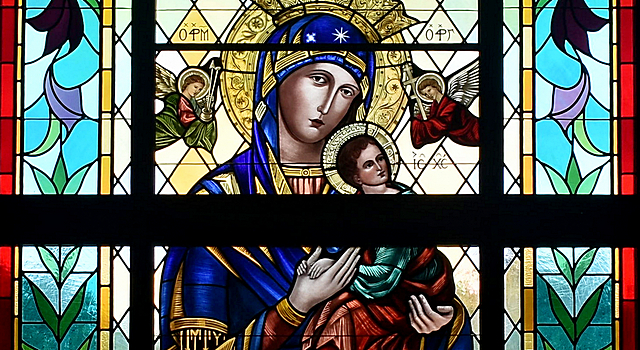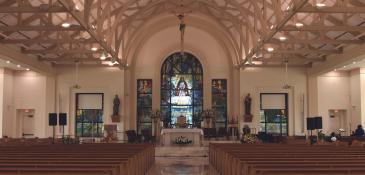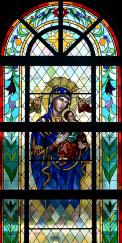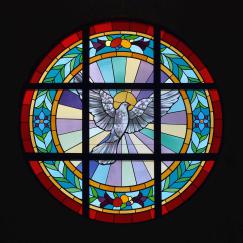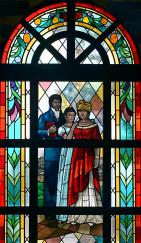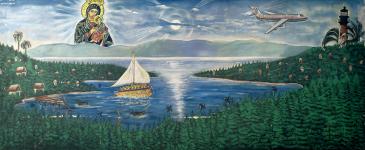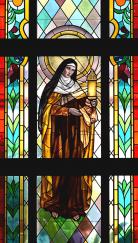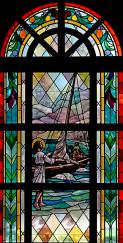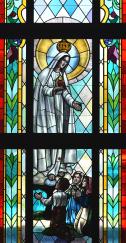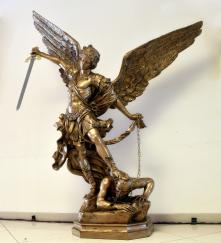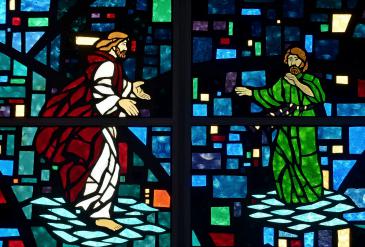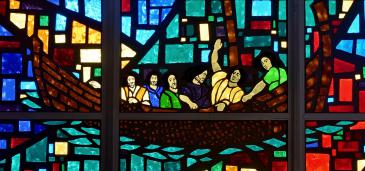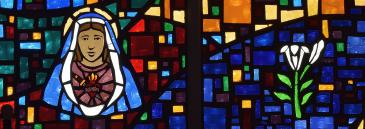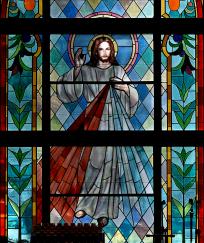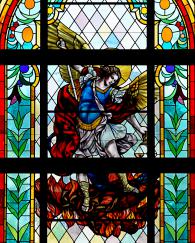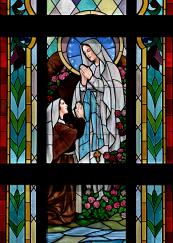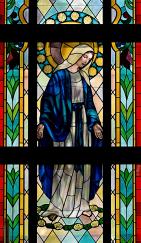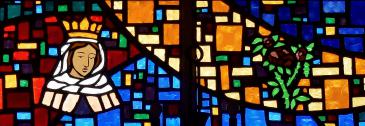By Jim Davis - Florida Catholic
Photography: Jim Davis
MIAMI | Many Catholics may not know August as “Lady Month,” but they’ll likely guess the honoree’s name: Mary. She is the subject of summertime celebrations in August, as well as springtime devotions in May.
For her numerous roles – including mother of Christ, queen of heaven, guide of individual believers, the first disciple, patron saint of many lands – Mary holds special spots on the calendar.
Pope Pius XII declared in 1950 that she was “assumed,” or taken up into heaven body and soul. Although the Assumption is among the newest dogmas, its origins are lost in time.
When St. Helena made a fourth century pilgrimage to Jerusalem, locals told her of the “Place of Dormition” and an empty tomb which had been Mary’s. Thereafter, devotion to Mary spread throughout the Eastern Church, then the West as well.
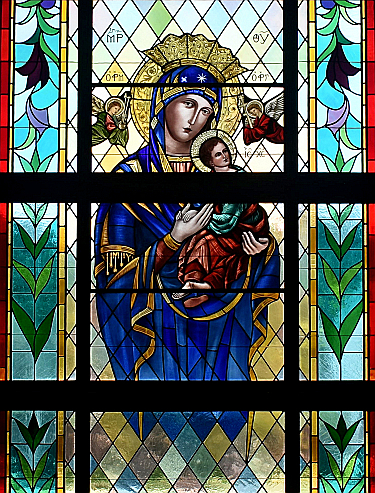
Photographer: Jim Davis | FC
Our Lady of Perpetual Help, the patron saint of Haitians, dominates the large chapel at Notre Dame d'Haiti.
Nowadays, the feast of the Assumption is celebrated worldwide on Aug. 15. The original sites, on Mount Zion and the Mount of Olives, still draw pilgrims.
Mary has been honored as Our Lady for centuries as well. In an eighth century sermon on the Assumption, St. John Damascene said, “You were transferred to your heavenly home, O Lady, Queen and Mother of God in truth.”
Her titles are closely related, according to the Marian Library at the University of Dayton. As Queen, she sits in heaven beside her son, the King of Glory. Her title of Lady is more personal, as “mistress of the place – monastery or convent.”
Her title of “Mother,” the Marian Library notes, combines the other two; for in Mary, “the exercise of regality is the maternal service of compassion.”
LADY, QUEEN, MOTHER
The concepts are even linked on the church calendar, with the Queenship of Mary falling on Aug. 22. Vatican II reaffirmed a fourth century belief that Mary was “exalted by the Lord as Queen over all things, that she might be fully conformed to her Son.”
Mary’s Queenship was originally celebrated in June, but Pope Paul VI moved it to August – taking place an “octave,” or eight days, after the Assumption.
August also covers three other Marian days:
- Our Lady of the Angels, Aug. 2, for the church that St. Francis of Assisi founded as the first of his ministry. It was so named because people said they often heard angelic singing there.
- Our Lady of the Snows, Aug. 5, for the Basilica of St. Mary Major in Rome. A medieval legend says that Mary indicated where to build the church – on Rome’s Esquiline Hill – by covering it with snow despite the summer heat in August.
- Our Lady, Refuge of Sinners, Aug. 13, revering Mary as the “New Eve.” Just as Eve helped bring sin into the world through disobedience, Mary was instrumental in salvation by bearing Christ. This devotion dates to the eighth century.
Even popular culture and legend honor Mary. The ladybug is said to be under her protection. “To kill a ladybug means to anger Our Lady for nine days,” according to the University of Dayton.
Numerous flowers are associated with her also. “Marigold” is short for “Mary’s Gold.” White lilies signify her purity and virginity. The Lily of the Valley is also called “Mary’s tears.” Pansies are “Our Lady’s Delight.”
Haitians, including parishioners at Notre Dame d'Haiti, have their own connection with Mary as Our Lady of Perpetual Help. Based on a 15th century icon made in Crete, she has been credited with several miracles.
In Haiti, people begged for her aid in 1862 when smallpox struck the island, killing an estimated 200,000. A drought made their plight even worse.
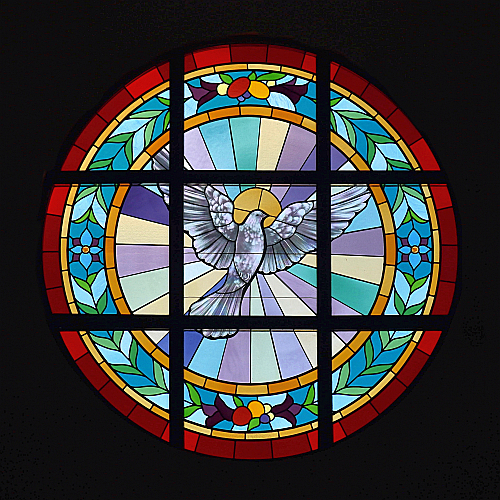
Photographer: Jim Davis | FC
A flying dove, an ancient symbol for the Holy Spirit, forms the rose window at Notre Dame d'Haiti.
Many flocked to a church in Port-au-Prince, where the archbishop said Mass before a copy of the Perpetual Help icon, which he had brought to Haiti. Shortly thereafter, the drought broke, and the plague receded.
A grateful Pius XII confirmed Our Lady of Perpetual Help as patroness of Haiti in 1942. His successor Pope Benedict XVI likewise invoked her aid in 2010 after the disastrous earthquake in the Port-au-Prince area.
At the Mission of Notre Dame d'Haiti in Miami, the icon has been made into a large stained-glass window dominating the east end of the building.
In the image, the Child grasps his mother’s hand, one sandal dangling from a foot. But he is looking away at the angels Michael and Gabriel, who are presenting the cross and other instruments of his future death.
FIVE DECADES IN MIAMI
Notre Dame d'Haiti’s roots go back five decades, when immigrants from the island worshiped at Corpus Christi Church in Miami. In 1977, St. Mary Cathedral provided another Haitian Mass on Sunday afternoons.
Father (now Archbishop) Thomas Wenski began ministering to Haitians in 1979, saying Mass at both sites. He also reached out to Haitians in Belle Glade, then Fort Lauderdale, Pompano Beach, Immokalee and elsewhere.
A year later, Haitians got their own center near St. Mary. That allowed them to form lay groups, including the Legion of Mary and the St. Vincent De Paul Society.
In the 1980s, the mission strained to serve new Haitian refugees. The late Archbishop Edward McCarthy moved the work to the Notre Dame Academy for Girls, with much of the repairs and renovations made by members themselves. The site became a center for legal aid and social services to Haitians.
In 2001, Father Reginald Jean-Mary launched a seven-day spiritual revival he called Jericho Week. The revival is still held each year, making Notre Dame d'Haiti a nexus for Haitian worship and community.
Father Jean-Mary was appointed pastor there in 2004. The following year, former Archbishop John Favalora blessed the Shrine of Our Lady of Perpetual Help on the church grounds.
Notre Dame d'Haiti finally got its own home in 2014. The $5 million project was the fruit of eight years of fundraising.
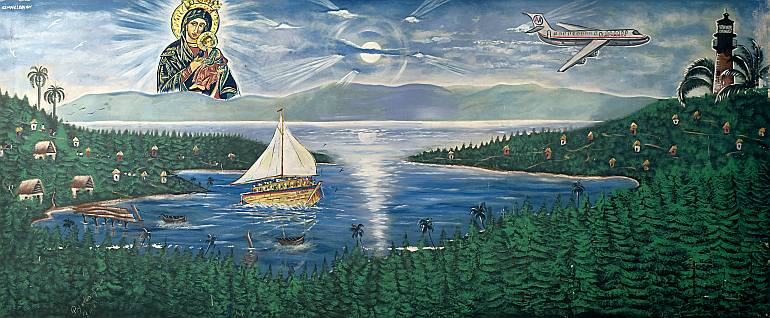
Photographer: Jim Davis | FC
Mural in the parish hall at Notre Dame d'Haiti shows the journey of Haitian refugees to freedom in America. Watching over them is Our Lady of Perpetual Help, their patron saint.
